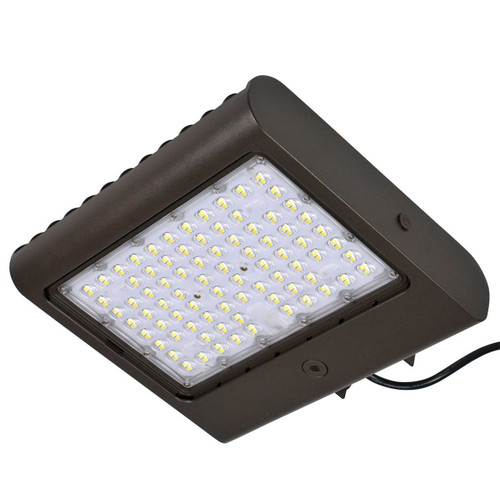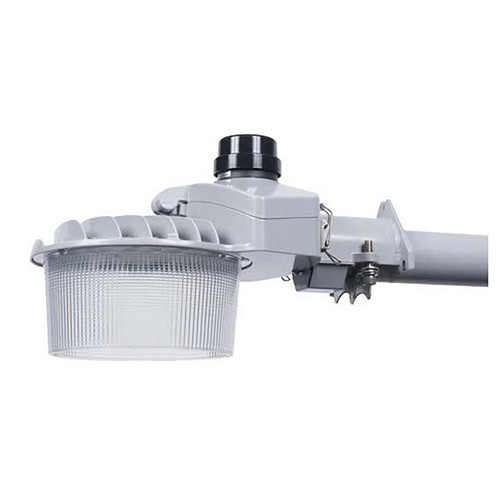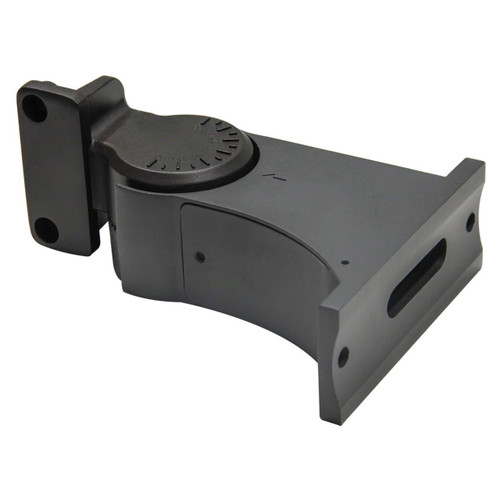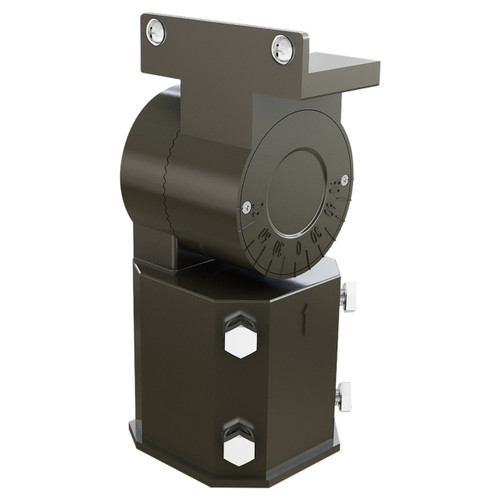-
LumeGen
SKU: LEDAREA1000051335
LED Wattage Tunable Area Light w/ Built-In Photosensor - 50W/80W/100W/150W - 5000K
Color Temp / CCT: 5000KVoltage: AC100-277VWarranty: 5 YearLumens per Watt: 142 lm/WLumens: 7050/11,280/14,100/21,150Wattage: 50W/80W/100W/150W AdjustableRatings and Certifications: DLC PremiumRatings and Certifications: UL ListedRatings and Certifications: FCC CompliantRatings and Certifications: RoHS CompliantRatings and Certifications: Wet Location$79.99As low as $79.99
In Stock -
LumeGen
SKU: LEDAREA1000050733
LED Wattage Adjustable Area Light Shoebox - 200W/240W/300W - 5000K - LumeGen
Lumens per Watt: 130 lm/WVoltage: AC120-277VWarranty: 5 YearWattage: Wattage Adjustable 200W/240W/300WRatings and Certifications: DLC PremiumRatings and Certifications: UL ListedLumens: 26,000/31,200/39,000$124.99In Stock -
LumeGen
SKU: LEDAREA1000051336
LED Wattage Adjustable Area Light w/ Built-in Photosensor - 150W/200W/240W/300W - 5000K
Voltage: AC100-277VWarranty: 5 YearLumens per Watt: 142 lm/WLumens: 21,150/28,200/33,840/42,300Wattage: 150W/200W/240W/300W AdjustableRatings and Certifications: DLC PremiumRatings and Certifications: UL ListedRatings and Certifications: FCC CompliantRatings and Certifications: RoHS CompliantRatings and Certifications: Wet Location$144.99$139.99As low as $139.99
In Stock -
LumeGen
SKU: LEDAREA1000050732
LED Wattage Adjustable Area Light Shoebox - 70W/100W/150W - 5000K - LumeGen
Lumens per Watt: 130 lm/WVoltage: AC120-277VWarranty: 5 YearWattage: Wattage Adjustable 70W/100W/150WRatings and Certifications: DLC PremiumRatings and Certifications: UL ListedLumens: 9100/13,000/19,500Ratings and Certifications: FCC CompliantRatings and Certifications: Wet Location$69.99In Stock -
Jen Lighting Corp.
SKU: LEDAREA1000050730
LED Wattage Adjustable Area Light Shoebox - 100W/150W - 5000K - Jen Lighting
Lumens per Watt: 130 lm/WLumens: 100W: 13,000 | 150W: 19,500Voltage: AC100-277VWarranty: 5 YearWattage: 100W/150WRatings and Certifications: FCC CompliantRatings and Certifications: UL ListedRatings and Certifications: Wet LocationRatings and Certifications: ROHS$93.97In Stock -
LumeGen
SKU: FLG_ST_SF806
Solar LED Flagpole Light - 720 Lumens - LumeGen
Lumens: 720Ratings and Certifications: RoHS CompliantRatings and Certifications: Wet Location$79.99As low as $79.99
In Stock -
Pinegreen Lighting
SKU: LEDSOLR1000051605
Solar LED 3-Head Security Light - 10W - 1500 Lumens - 5000K - Pinegreen Lighting
Color Temp / CCT: 5000KWarranty: 2 YearLumens: 1500Ratings and Certifications: Wet Location$25.00$19.98In Stock -
Pinegreen Lighting
SKU: LEDSOLR1000051607
Solar LED 3-Head Security Light - 28W - 5000K - Pinegreen Lighting
Color Temp / CCT: 5000KLumens: 2200Wattage: 28W$45.83$39.99In Stock -
Lumec by Signify
SKU: LEDAREA1000050734-BOX1
LED Roadway Security Luminaire, Medium - 70W - Type V - Lumec
Color Temp / CCT: 5000KLumens per Watt: 142 lm/WLumens: 7050/11,280/14,100/21,150Voltage: AC100-277VWarranty: 5 YearWattage: 50W/80W/100W/150W AdjustableRatings and Certifications: DLC PremiumRatings and Certifications: FCC CompliantRatings and Certifications: RoHS CompliantRatings and Certifications: UL ListedRatings and Certifications: Wet Location$59.97In Stock -
Lumec by Signify
SKU: LEDAREA1000050735-BOX1
LED Roadway Security Luminaire, Medium - 70W - Type III - Lumec
Color Temp / CCT: 5000KLumens per Watt: 142 lm/WLumens: 7050/11,280/14,100/21,150Voltage: AC100-277VWarranty: 5 YearWattage: 50W/80W/100W/150W AdjustableRatings and Certifications: DLC PremiumRatings and Certifications: FCC CompliantRatings and Certifications: RoHS CompliantRatings and Certifications: UL ListedRatings and Certifications: Wet Location$59.97In Stock -
Gama Sonic
SKU: LEDSOLR1000051242
Solar Security & Area Light - with Motion Sensor and Timer - 810 Lumens - 6000K - Gama Sonic
Color Temp / CCT: 6000KLumens: 810Wattage: 4WRatings and Certifications: Wet Location$89.99$79.99In Stock: Ships in 3 to 5 business days -
Gama Sonic
SKU: LEDSOLR1000051243
Solar Security & Area Light - with Motion Sensor and Timer - 2800 Lumens - 6000K - Gama Sonic
Color Temp / CCT: 6000KLumens: 2800Wattage: 16WRatings and Certifications: Wet Location$249.99$239.99In Stock: Ships in 3 to 5 business days -
Gama Sonic
SKU: LEDSOLR1000051287
Solar LED Plaza Gooseneck Light - 180 Lumens - 2700K - Black Finish - Gama Sonic
Color Temp / CCT: 2700KLumens: 180Ratings and Certifications: Wet Location$299.99$249.99In Stock: Ships in 3 to 5 business days -
Venas
SKU: LEDAREA1000051683
LED Wattage Adjustable Area Light Shoebox - 80W/100W/150W - Venas
Lumens per Watt: 140 lm/WLumens: 80W: 11,200 | 100W: 14,000 | 150W: 21,000Voltage: AC120-277VWarranty: 5 YearWattage: 80W/100W/150WRatings and Certifications: DLC PremiumRatings and Certifications: Wet LocationRatings and Certifications: ROHS$111.67In Stock: Ships in 1 to 2 business days -
Venas
SKU: LEDAREA1000051684
LED Wattage Adjustable Area Light Shoebox - 100W/150W/200W - Venas
Lumens per Watt: 140 lm/WLumens: 100W: 14,000 | 150W: 21,000 | 200W: 28,000Voltage: AC120-277VWarranty: 5 YearWattage: 100W/150W/200WRatings and Certifications: DLC PremiumRatings and Certifications: Wet LocationRatings and Certifications: ROHS$130.00In Stock: Ships in 1 to 2 business days -
Venas
SKU: LEDAREA1000051685
LED Wattage Adjustable Area Light Shoebox - 150W/200W/300W - Venas
Lumens per Watt: 140 lm/WLumens: 150W: 21,000 | 200W: 28,000 | 300W: 42,000Voltage: AC120-277VWarranty: 5 YearWattage: 150W/200W/300WRatings and Certifications: DLC PremiumRatings and Certifications: Wet LocationRatings and Certifications: ROHS$159.99In Stock: Ships in 1 to 2 business days -
Pinegreen Lighting
SKU: LEDSOLR1000051606
Solar LED Dual Head Security Light - 20W - 5000K - Pinegreen Lighting
Color Temp / CCT: 5000KLumens: 1500Wattage: 20W$39.17In Stock: Ships in 7 to 10 business days -
Pinegreen Lighting
SKU: LEDSOLR1000051608
Solar LED Motion Activated Security Light - 8W - 1000 Lumens - 5000K - Pinegreen Lighting
Color Temp / CCT: 5000KLumens: 1000Wattage: 8W$33.00In Stock: Ships in 7 to 10 business days -
Gama Sonic
SKU: LEDSOLR1000051286
Solar LED Yard Area Light - 100 Lumens - 3000K - Gama Sonic
Color Temp / CCT: 3000KLumens: 100Ratings and Certifications: Wet Location$49.99In Stock: Ships in 3 to 5 business days -
Pinegreen Lighting
SKU: LEDAREA1000051606
Battery Powered LED Security Light - 8W - 1000 Lumens - 5000K - Pinegreen Lighting
Color Temp / CCT: 5000KLumens: 1000Wattage: 8W$19.99In Stock: Ships in 7 to 10 business days -
Gama Sonic
SKU: LEDSOLR1000051249
Solar LED Area Light with Motion Sensor - 500 Lumens - 6000K - Gama Sonic
Color Temp / CCT: 6000KLumens: 1440Ratings and Certifications: Wet Location$159.99In Stock: Ships in 3 to 5 business days -
LumeGen
SKU: LEDSOLR1000051625
Less-Than-Perfect - Solar LED Area Light - 6000K
Color Temp / CCT: 6000KWarranty: 2 YearLumens: 500Ratings and Certifications: Wet Location$100.00In StockOnly 5 in stock -
HG Lighting
SKU: LEDAREA1000051209
LED Area Light - 300W - 43,500 Lumens - 5000K - HG Lighting
Color Temp / CCT: 5000KLumens per Watt: 145 lm/WVoltage: AC100-277VWarranty: 5 YearLumens: 43500Wattage: 300WRatings and Certifications: CE CertifiedRatings and Certifications: DLC PremiumRatings and Certifications: FCC CompliantRatings and Certifications: RoHS CompliantRatings and Certifications: UL ListedRatings and Certifications: Wet Location$220.83$144.97In StockOnly 3 in stock -
Probrite
SKU: LEDAREA1000055003
LED Security Area Light - 150W - 20,000 Lumens - 4000K
Color Temp / CCT: 4000KLumens per Watt: 135 lm/WLumens: 20,000Voltage: AC120-277VWarranty: 5 YearRatings and Certifications: FCC CompliantRatings and Certifications: UL ListedRatings and Certifications: Wet LocationWattage: 150W$224.30$174.99In Stock: Ships in 5 to 7 business days -
Probrite
SKU: LEDAREA1000055002
LED Security Area Light - 100W - 14,000 Lumens - 4000K
Color Temp / CCT: 4000KLumens per Watt: 140 lm/WLumens: 14,000Voltage: AC120-277VWarranty: 5 YearRatings and Certifications: FCC CompliantRatings and Certifications: UL ListedRatings and Certifications: Wet LocationWattage: 100W$179.42$149.99In Stock: Ships in 5 to 7 business days -
Probrite
SKU: LEDAREA1000055001
LED Security Area Light - 64W - 8500 Lumens - 4000K
Color Temp / CCT: 4000KLumens per Watt: 132 lm/WLumens: 8500Voltage: AC120-277VWarranty: 5 YearRatings and Certifications: FCC CompliantRatings and Certifications: UL ListedRatings and Certifications: Wet LocationWattage: 64W$79.99In StockOnly 1 in stock -
Probrite
SKU: LEDAREA1000055000
LED Security Area Light - 32W - 4500 Lumens - 4000K
Color Temp / CCT: 4000KLumens per Watt: 140 lm/WLumens: 4500Voltage: AC120-277VWarranty: 5 YearWattage: 32WRatings and Certifications: FCC CompliantRatings and Certifications: UL ListedRatings and Certifications: Wet Location$64.99In Stock: Ships in 5 to 7 business days -
Venas
SKU: LEDAREA1000051680
LED Area Light Shoebox - 100W - Venas
Lumens per Watt: 140 lm/WLumens: 14,000Voltage: AC120-277VWarranty: 5 YearWattage: 100WRatings and Certifications: DLC PremiumRatings and Certifications: Wet LocationRatings and Certifications: ROHS$86.67In Stock: Ships in 1 to 2 business days -
Venas
SKU: LEDSPRT100002005
LED Sports Light - 650W - 97,500 Lumens - 5000K - 30 Degree - Venas
Color Temp / CCT: 5000KLumens per Watt: 150 lm/WLumens: 97,500Voltage: AC120-277VWarranty: 5 YearWattage: 650WRatings and Certifications: ETL ListedRatings and Certifications: RoHS Compliant$600.00In Stock: Ships in 1 to 2 business days -
Venas
SKU: LEDSPRT100002004
LED Sports Light - 500W - 65,000 Lumens - 5000K - Venas
Color Temp / CCT: 5000KLumens per Watt: 130 lm/WLumens: 65,000Voltage: AC100-277VWarranty: 5 YearWattage: 500WRatings and Certifications: DLC PremiumRatings and Certifications: ETL ListedRatings and Certifications: RoHS Compliant$566.67$545.00Available -
$18.00In Stock
-
$5.99In Stock
-
Jen Lighting Corp.
SKU: LEDLHLS1000050734
Twist-Lock Photocell Control for Area Light - Jen Lighting
$9.99In Stock -
$11.67In StockOnly 4 in stock
-
$15.00In Stock
-
$15.00In Stock
-
LumeGen
SKU: LEDMKAL1000050701
Type B Square/Round Pole Mount with Knuckle Bracket for LED Area Light Shoebox - LumeGen
$20.00In StockOnly 13 in stock -
$15.00In Stock
-
$20.00In Stock: Ships in 1 to 2 business days
-
$20.00In Stock: Ships in 1 to 2 business days
-
$20.00In StockOnly 1 in stock
-
$16.67In Stock: Ships in 1 to 2 business days
-
$16.67In Stock: Ships in 1 to 2 business days
-
$22.39In StockOnly 5 in stock
-
$6.99In StockOnly 15 in stock
-
Morris
SKU: LEDAREA1000051625
LED Wattage & Color Adjustable Area Light Shoebox - 60W/80W/100W - Gen 4 - Morris
Lumens per Watt: 132 lm/WLumens: 13,586 @ 80WVoltage: AC120-277VWarranty: 5 YearWattage: 60W/80W/100W AdjustableRatings and Certifications: DLC PremiumRatings and Certifications: FCC CompliantRatings and Certifications: UL ListedRatings and Certifications: Wet Location$150.00$99.97In StockOnly 5 in stock -
HG Lighting
SKU: LEDAREA1000051206
LED Area Light - 100W - 15,000 Lumens - 5000K - HG Lighting
Color Temp / CCT: 5000KLumens per Watt: 150 lm/WLumens: 15,000Voltage: AC100-277VWarranty: 5 YearWattage: 100WRatings and Certifications: CE CertifiedRatings and Certifications: DLC PremiumRatings and Certifications: FCC CompliantRatings and Certifications: RoHS CompliantRatings and Certifications: UL ListedRatings and Certifications: Wet Location$93.07$74.97In StockOnly 2 in stock -
$17.96In StockOnly 12 in stock
Light Up Parking Lots and Streets with LED Area Lighting
Reduce electricity costs and improve visibility of roadways, parking lots, loading docks and warehouse entrances with this range of LED area lights (aka parking lot lights, street lights, or pole lights). The weather resistance and long lifespan of these outdoor lights make them a reliable replacement for older metal halide lighting while still offering vivid illumination in commercial and industrial environments.
Why choose an LED Area Light or LED Parking Lot Light for security?
LED Parking Lot Lights are ideal for illuminating large outdoor areas such as parking lots, airports, schools, universities, warehouses, community parks, and more! LED Parking Lot lights offer a sense of security to the users of outdoor spaces by providing bright light during the dark night.
LED parking lot lights provide a large amount of light while reducing the maintenance cost and increasing energy efficiency. Many LED parking lot lights stay bright up to 100,000 hours - compare that to having to replace an HID bulb every 6000-15,000 operational hours. Running 12 hours a day, that's over 22 years of light! Compare that with just over 3 years of light for an HID bulb before having to replace it, at best. Another advantage of LED parking lot lights over HID is the consistency of the light color over it's lifespan; HID systems fade quickly and turn yellow over time while LED parking lot lights maintain their color temperature for the life of the fixture.
How Do LED Area Lights Compare to Metal Halide Commercial Light Poles?
The metal halide technology traditionally used to illuminate parking lots, walkways and other outdoor areas provides visibility over a substantial distance while using less power than incandescent bulbs but struggles to maintain consistent color and light intensity throughout its 15,000-hour lifespan. It also typically requires a 15-to-20-minute warm-up period to reach maximum illumination, making it better suited to applications where the light remains on for long periods.
LED area lights attain maximum brightness rapidly and don't need a warm-up period, like metal halide lights. They maintain consistent and precise color temperature and have a lifespan of up to 50,000 hours or longer, which minimizes replacement costs, maintenance and hassle. They can be installed with photosensors, motion sensors, and remote controls for even more controllability of the light.
Are LED Pole Outdoor Area Lights Worth the Cost?
Advances in manufacturing and widespread adoption of LED lighting have allowed the price difference to shrink over the years, bringing it closer to other technologies. Not only are LEDs now cheaper than ever, but the initial investment often pays for itself many times throughout the lifespan of the light because high-quality LED pole lights can easily last up to 20 years before replacement is necessary.
LED area lighting also uses significantly less electricity to produce the same light output as other technologies — including efficient fluorescent or sodium vapor lights — making it the least expensive option for use in fixtures that need to remain on all night.
LED Area Light Rebates
Multiple sources of rebates cover up to 74% of the United States, forming an active commercial lighting rebate program. These rebates may include LED area lights and other forms of outdoor area lighting, providing additional savings for businesses switching old site lights to efficient technology.
What LED Area Lighting is Best?
The best implementation of lighting depends on the space that needs illumination and the environmental conditions. Most LED parking lot lights, floodlight poles and other outdoor solutions have an IP waterproof rating, allowing operation in wet conditions and ensuring dependability even during rain. Many can also be operated automatically with an optional photocell that detects sunlight and activates the lamp when night begins.
The type of mount used — whether a pole, slipfitter, wall or trunnion mount — controls the angle and intensity of the light, allowing its presentation to be customized. Choose from several available mounts to tailor the illumination to a particular space or application.
What is the difference between an area lighting fixture and directional light?
The primary difference between an LED area lighting fixture and directional light lies in how they distribute light. Area Lighting Fixture are designed to provide a wide and even distribution of light over a larger space. They typically cast light in all directions or over a wide angle. This is useful for generally illuminating open areas such as parking lots, sidewalks, or building exteriors. Directional Light focuses light into a specific direction or onto a targeted area. These lights are designed to provide illumination to a concentrated or specific location like highlighting architectural features or as accent lighting.
How do I choose the right Light Distribution for an LED Area Light?
An important factor to consider when selecting LED Area light is the light distribution of the fixture. The Illuminating Engineering Society of North America (IESNA) introduced a classification system for light distribution patterns. The light distribution refers to the pattern of light that the fixture disperses on the target lighted area. For example, the light distribution for a narrow roadway may require a narrower pattern of light to maximize brightness over the narrow area whereas the light distribution required for the middle of a parking lot may require a larger, more round light pattern to even distribute light all around the light source. There are 5 main types of light distribution patterns:
Type I Light Distribution
is a linear, oblong pattern that is ideal for placement in the center of narrow walkways or roads. It has a preferred lateral width of 15 degrees that is suitable for lighting walkways or roads that are up to 2 times as wide as the mounting height.
Type II Light Distribution
is still a linear pattern but it is wider on the sides. Type II light has a lateral width of 25 degrees which is suitable for wider walkways or roads such as 4-lane roads or on-ramps. Type II light can illuminate areas with a width that is no more than 1.75 times the height that the fixture is mounted.
Type III Light Distribution provides lighting for a larger area projecting outward from the perimeter. It has a lateral width of 40 degrees which is suitable for driveways or sports fields. Type III light can illuminate areas with a width that is no more than 2.75 times the height that the fixture is mounted.
Type IV Light Distribution
(aka "Forward Throw") is similar to the Type III pattern but wider. It has a lateral width of 60 degrees and throws light the furthest out from where it's mounted (hence the forward throw). It is ideal for parking lots or building walls. Type IV light can illuminate areas with a width that is no more than 2.75 times the mounting height that the fixture is mounted.
Type V/VS Light Distribution
is a circular (Type V) or square (Type VS) pattern that distributes light evenly around the fixture. With even distribution around the light, this application is great for parking lots or large open areas.
What is site lighting?
The purpose of site lighting is to illuminate walkway areas to provide safe passage through landscaping, around constructions sites, parking garages, warehouses, parking lots, streets or any walk way.
Are you looking for Retrofit Old MH Area Light Bulbs?
You can shop our selection of Retrofit Area Light Bulbs here.

























































